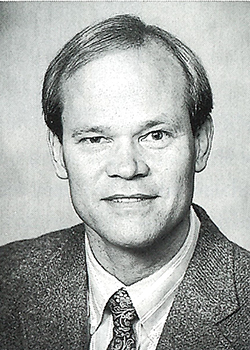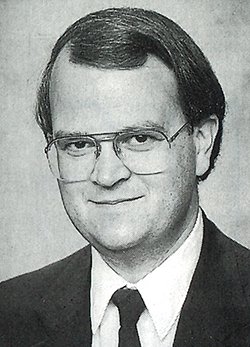Class gives business students a taste of Wall Street
A month into his Fall Quarter investments class, Finance Professor V. Vance Roley watched a nervous senior give an oral report.
The business major said current market conditions were unstable and that there were disturbing similarities between the Wall Street of that day and the Wall Street of 1929.
“He asked if this means there will be a crash. I answered, `Of course not. There is not going to be a crash,’ ” Roley recalls.
Six days later, on October 19, 1987, the Dow Jones industrial average lost 508 points—its most spectacular drop in history. Roley walked into the classroom following Black Monday, took a deep breath, and dismissed the student’s prediction as “a one in a million” coincidence.
“I thought the market did go down too far—it was grossly mispriced—and I thought it might go back up,” he says. And Roley was right. In 16 months, the average returned to levels seen just before the crash.
It’s a world of bulls and bears, of booms and busts, and the business school wouldn’t have it any other way. Just as the UW sends its forestry students to the Pack Forest Experimental Station and puts is oceanography students on the R.V. Thomas G. Thompson in the middle of Puget Sound, it places some of its business students in their own real world laboratory—Wall Street.
Each quarter about 35 undergraduates and 35 M.B.A. students enroll in Finance 460 or 550, “Investments,” a course that usually fills up the day it opens and often has a waiting list.
At some business schools with investment courses, student teams are given a set amount of money the first day—say $1,000—and told to invest it in the financial markets. At the end of the course, part of the grade depends of how well the teams do.
At the University of Washington, professors don’t put students under that financial gun. “We don’t ask them to purchase a portfolio before they know anything about the market. The best time for that would be at the end of the quarter, not the beginning,” says Roley.

Wayne Ferson
In fact, other schools may drop that tactic. “There are really a number of opportunities to trade `paper portfolios’ over the Internet without actually purchasing anything,” notes Wayne Ferson, who is the Paul Piggott-PACCAR Professor in Business Administration.
For extra credit in his courses, Ferson urges his students to sign up with Stock Trader in Atlanta, a service which makes fictitious transactions. “The students put together a portfolio and the company acts as their broker. The firm does the trades at the market rate, charges students fees, allows options and futures trades and even handles margin accounts,” he explains.
Roley’s classes indulge in fact as well as fiction. At the beginning of each class, he looks at the performance of the S&P 500 since the last meeting. “We look at what are the movements and why. It makes sense as they are learning this subject,” he explains.
To keep abreast of current events, Roley suggests that his students subscribe to the Wall Street Journal and follow news events closely. “I try to explain to them how the news affects both the short-term trend and influences the market in the long run as well.”
Kellie Craine, ’87, now an investment manager for the state of Washington, remembers Roley’s course well. “This class was one of my favorites. To this day, I still call Professor Roley and talk to him about the economy,” she says.
When Craine took the course, the junk bond market was riding high. Many firms were fighting hostile takeovers. During the current events discussion, she and another student questioned Roley about Ivan Boesky and Michael Milken. “Is it right to dismantle companies and force buyouts, we asked him. Most of the other business students didn’t seem to care, but we asked, where are the morals. There is a right and a wrong way. We spend most of the morning discussing it,” Craine says. Just a few months later, both Boesky and Milken were charged with insider trading.
In contrast to the current events approach, Finance Professor Ferson says his courses don’t follow the news “religiously.” “I’d rather give them the ideas and tools that will be around for a while,” he says. He depends on historic data for both his teaching and his research and often puts his databases on school computers so that students can use them in their reports.
Though the two professors take different approaches in their market labs, both say that the financial markets help explain fundamental principles of finance—just as studying a salmon run helps explain biological principles.

V. Vance Roley
“One of the main laws they learn is the benefits of a diversified portfolio,” says Roley. “They see the benefits in the short run and the long run.”
“They understand the basic mechanism of how a portfolio works,” adds Ferson. “What is diversification? When does it work for better or for worse? And what are the risks in the context of a portfolio.”
For example, holding Microsoft stock in a portfolio already heavily invested in computer stocks is riskier that the same amount of Microsoft stock in a more evenly spread portfolio.
Both professors have students create fictitious investment portfolios. Ferson adds a touch of drama to his financial labs: He pretends he is one of three characters whom students must interview and then design the perfect portfolio.
“Joe Fastback” is a young M.B.A. just out of school with a well-paying job as a sales manager. He has just inherited a chunk of money from his grandmother. “Sam Sedate” is a middle-aged insurance officer with two children getting ready for college and a Keogh retirement plan. “Phil Coot” is a retired engineer from Skybarge Aerospace who has a pension and some assets.
Ferson then grades the portfolios, “not on how the portfolio performs, but on the logic of the choices,” he explains.
When he took Ferson’s course, business senior Phillip Yin and five other students created their own mock mutual fund, which they called the “Cascade Fund.” “We focused on undervalued stock in high tech and telecommunications industries,” Yin recalls. Over a three month period, Yin says, the fund achieved a 6 to 7 percent rate of return.
In Roley’s courses students build a portfolio and also track an individual stock through the quarter. “For their individual stock, they seem to favor local stocks—Microsoft, Boeing, Nordstrom, Weyerhaeuser—and lots of beer companies. I long ago learned that the New York Stock Exchange symbol of Anheiser-Busch was `BUD,’ ” he says.
Ferson’s students also tend to have a “home bias.” “That’s nothing unusual, since there is a home bias in the investment world in general,” he notes. “Investors favor equities in their own country relative to other countries, despite the returns. This is true in America and in Japan. It is a hot research topic right now.”
Even though students are not graded on stock performance, that doesn’t mean that some of the students are not already playing the market on the side.
“A lot of my students are making trades, and some of them are getting a higher return than the average,” says Roley.
One of his students found a “trading rule,” a way to make a favorable trade, often taking advantage of price differentials between markets. In this case, the student discovered a trading rule in the options market. In a 2 for 1 stock split, the shares in the options market would be mispriced right after the split. Eventually the options market went back to the right price level.
Roley says his student explored the rule in an independent study project—and at the same time made a very favorable return in the options market. But a few months later, the same trading rule turned up in a financial journal as part of a professor’s paper. Once widely discovered, the advantage of playing a trading rule disappears as traders are now aware of the discrepancy.
Today, with Wall Street in its seventh year as a bull market, most students who play the market are going to be winners. But, both professors warn, a downturn is inevitable. It is not something that their students seem to understand.
“Many of them were too young to be aware of what happened in 1987,” says Ferson. “Until you’ve experienced a market downturn, it can be hard to believe it.”
“My students really don’t understand that the market can go down. I have to show them the numbers from 1968-79, when it was as bad as it is good now. People were losing money in real terms,” adds Roley.
Business student Yin agrees. Even though he has worked as a broker for Prudential and Smith Barney, when it comes to bull markets, he says, “Everyone is naive, including me. It’s tough. Most of us haven’t seen a bearish market.”
While the market may go up and down, demand for the investment courses will continue to rise. Open only to business majors, usually only seniors get into the undergraduate course because they have top registration priority.
It is worth the wait. “It’s better than the typical course,” says Yin. “It’s really a course that most students need. It was not one of those courses where you walk out and ask yourself, `When am I ever going to use any of this?’ ”
“This was the class that did it,” says former student Craine. “I realized that I love this stuff, that this is what I wanted to do when I grew up.”
Mission impossible: predicting market trends
“I have no confidence in predicting anything,” says Finance Professor V. Vance Roley. “I used to think you might be able to predict long-term rates, but the market is so efficient nowadays, it immediately takes those factors into account.”
Roley ends to ignore the “technical” side of market analysis. He says investors need to look at two overall factors: the inflation rate and the performance of the economy. “If inflation increases, the Federal Reserve is going to tighten quickly. And if the economy looks very strong, the Fed is going to tighten.”
To watch the economic performance, he says investors should watch labor market trends and the rates in domestic GNP.
Roley worked at the Federal Reserve Bank in Kansas City and still is a consultant for the Fed. He feels the board has done pretty well with the economy—even during a Presidential election year.
“The Fed has ignored the political pressures and pretty much does the right thing,” he says. “They are pretty well insulated. After all, their terms are for 14 years. Of course, they are a creation of Congress and lawmakers could always dissolve the Fed—but they won’t. It would cause too much of a panic.”
The feeling is mutuals: funds aren’t such bad performers
UW Finance Professor Wayne Ferson has been tracking the history of mutual fund performance for years, comparing orthodox and unorthodox measurements. Using traditional performance standards, a financial analyst looking at 67 mutuals funds in the 1970s and ’80s would find that two-thirds performed worse than the S&P 500.
But before you take your money to a straight index fund, Ferson suggests looking at non-traditional performance measurements. During bull markets, so much money pours into mutual funds that managers don’t invest it all at once. Using a model that does not penalize funds for holding more cash during a bullish market, Ferson found that only 52.4 percent of the sample funds underperformed the S&P 500.
“The bias is to see mutual funds as underperforming. My studies seem to indicate that those criticisms may have been overblown,” he says.
However, mutual funds managers are also considered bad at market timing. “My current project tends to confirm that,” Ferson says. “Mutual funds tend to sit on more cash under high market returns.”